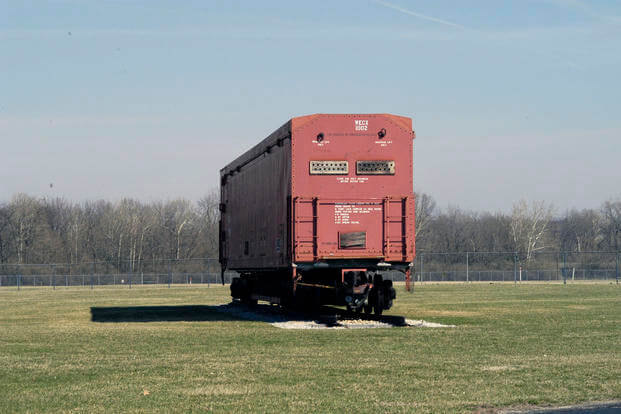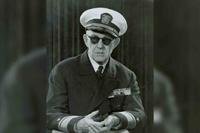The Cuban Missile Crisis was two decades in the rearview, but in the early 1980s, Cold War tensions between the United States and Soviet Union remained feverishly high.
In particular, 1983 served as a dangerous flashpoint, with the distrust and paranoia between the East and West amped up after the Soviets shot down Korean Air Lines Flight 007 and nearly misinterpreted a NATO exercise simulating a nuclear attack for the real thing. That year also saw the Air Force successfully flight-test the Peacekeeper intercontinental ballistic missile for the first time as the Defense Department sought to develop a mobile ICBM system. U.S. military leaders were playing a game of catch-up, though, because the Soviets already had deployed one. As a 2022 Air & Space Forces Magazine article put it: “In 1983, the two nuclear superpowers were like blindfolded boxers careening toward a death match.”
The Air Force’s Strategic Air Command, which largely oversaw the bombing capability of America’s nuclear weapons from 1946 until 1992, had been trying to implement a mobile ICBM system since 1971, but struggled to reach a consensus on what that would look like. Finally, President Ronald Reagan, who had labeled the Soviet Union “the Evil Empire” during a March 1983 speech, issued a national security directive on Dec. 19, 1986, to develop the Peacekeeper Rail Garrison program.

According to a 1992 assessment of the project by Air Force Lt. Col. Terrence G. Crossey, 25 of the military service’s trains would hold two 71-foot Peacekeepers apiece, totaling 50 missiles overall, with another fifty missiles designated for Minuteman silos. The trains would be located at the program’s main operating base, F.E. Warren Air Force Base in Wyoming, and garrisons at six other bases, dispersed onto the U.S. rail network only when the strategic alert level hit a certain point.
Under those circumstances, the trains would travel over thousands of miles of the country’s commercial railways, an impressive figure but a fraction of the more than 200,000 miles of track at the time, according to the Association of American Railroads. Along with the Peacekeeper weapons not being concentrated at one site, that mobility would increase the chances exponentially of the stockpile surviving a single strike by the Russians.
Even by ICBM standards, the Peacekeepers were extremely powerful. They were the most advanced and accurate ICBMs in America’s arsenal during the Cold War; while the Minuteman III (the missiles they were supposed to replace but ultimately did not) carried two or three warheads, the Peacekeeper could be fitted with 10 or 12, thus allowing it to strike more targets -- some as far as 7,000 miles away. The first Peacekeeper flight test was conducted at Vandenberg Air Force Base (now Vandenberg Space Force Base) in California in 1983.
Despite the progress on the missiles themselves, opinions about the Rail Garrison project were decidedly mixed among Defense Department officials and in Congress. Through the years, myriad basing options had been considered, including placing the Peacekeepers in submarines or on jets. Not surprisingly, a consensus was hard to achieve in that climate, and as a result, the train-based deployment system never fully received the complete backing of the powers-that-be.
There were other issues -- overly optimistic target dates, the project clashing with other military initiatives as the federal government moved to modernize the armed forces, survivability concerns -- but like so many other things in life, money was a prime concern. Not counting the missiles, the Government Accountability Office estimated the price tag of the Rail Garrison at $7.4 billion (roughly $18.4 billion in today’s dollars).
The expense certainly gave Congress pause. In what Crossey, the Air Force lieutenant colonel, described as the first “death blow” to the program, lawmakers declined to fund the construction of updated facilities at Warren AFB in September 1989. Congress also trimmed financing for research and development for fiscal years 1989 through 1991.
Those hurdles proved too much to overcome. Three years after the Pentagon OK’d the Rail Garrison for full development, President George H.W. Bush terminated the program in 1991 as the Soviet Union crumbled and the Cold War ended.
“The role of advocacy, or lack of it, essentially doomed the program from the start,” Crossey wrote.
While no ICBM made its way onto U.S. railroads, Peacekeepers stayed on until 2005 when they were phased out as part of the Strategic Arms Reduction Talks (START) between the U.S. and Russia. Their warheads were transferred to Minuteman IIIs. The National Museum of the U.S. Air Force in Dayton, Ohio, obtained a Rail Garrison car in 1994, where it remains on display today.
While the U.S. and Russia had rail-based ICBM launch systems in the past -- the Russians ending theirs in the early 2000s -- North Korea has touted that ability much more recently, as this video from 2021 shows.
Want to Know More About the Military?
Be sure to get the latest news about the U.S. military, as well as critical info about how to join and all the benefits of service. Subscribe to Military.com and receive customized updates delivered straight to your inbox.
















